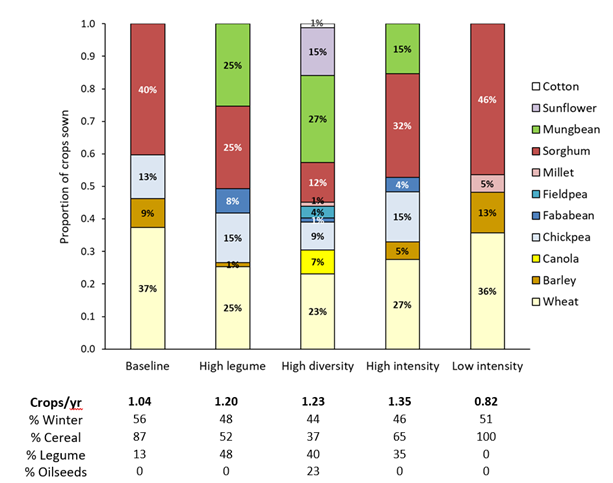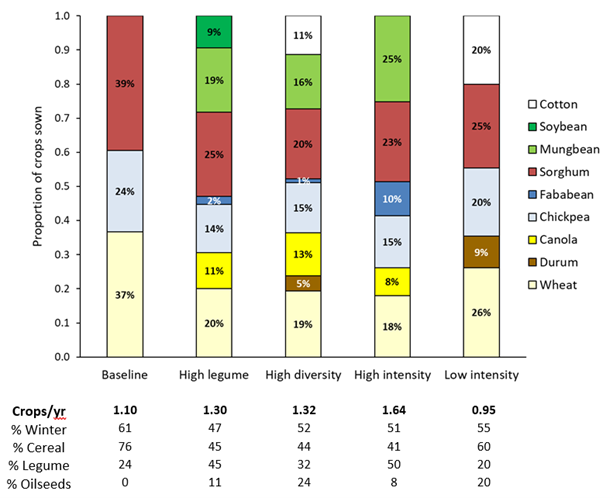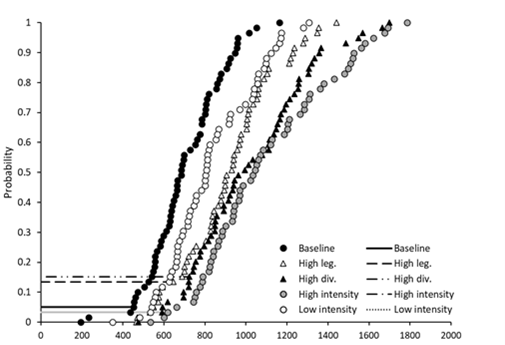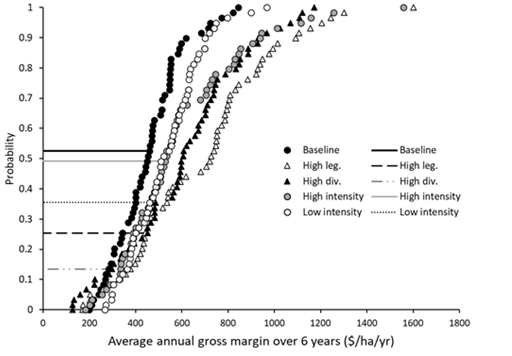Short and long-term profitability of different farming system strategies in NNSW
Author: Lindsay Bell (CSIRO), Jon Baird (NSW DPI), Andrew Erbacher (DAF Qld), Jeremy Whish (CSIRO) & Heidi Horan (CSIRO)1 | Date: 19 Jul 2023
Take home message
- Farming system decisions – crop choice and soil water required for sowing can have a large influence on system profitability over the short- and long-term; differences of >$100/ha/yr occur regularly
- While the last 6 years have presented a diverse range of seasons, this period does not necessarily reflect the potential of alternative farming strategies to enhance long-term profitability
- Adjusting soil water triggers to sow crops can also provide advantages over conventional approaches, particularly during more favourable periods
- Systems involving alternative crop types can not only help manage biotic threats (e.g., diseases and weeds) but also be profitable compared with conventional systems
- Greater diversity of crops offered wider range of sowing windows allowing potential to make use of variable rainfall conditions
- Simulated predictions of relative profitability of the systems generally correspond well with those calculated from experimental data over the same period.
Introduction
The northern farming systems project has been examining how different farming system strategies impact on various aspects of the farming system since 2015. Across a diverse range of production environments, we have tested the impacts of changing:
- the mix of crops grown by increasing the frequency of legumes or diversifying crop choices to provide disease breaks, or
- the intensity of the cropping system, by either increasing it by reducing the soil water threshold to sow more crops, or by reducing it and only growing higher profit crops once the soil profile is full; and
- the supply of nutrients provided to crops.
Despite now collecting data for over 6 years on each of these farming strategies, the full range of climatic conditions that are experienced across the region have not been captured. In particular, most sites have experienced extremely dry periods over the past 6 years, which is likely to bias or favour some particular farming systems. Simulation modelling can be useful to help explore how the different farming strategies might perform over the long term and under a range of climatic conditions. In this paper we compare APSIM predictions of system profitability over the long term with those for the period 2016–2021. This paper reports specifically on results from the two sites in the Border Rivers region, Billa Billa and Narrabri.
System simulations and estimates of profitability
The different farming systems were simulated from 1957 to 2021 using APSIM. Soil type used in simulations was that characterised at each location, and long-term climate data were sourced from the closest meteorological station. For each farming system at each location, the simulation was provided a list of crops (prioritised), their sowing window, and minimum soil water required to allow them to be sown. An example of the rules dictating crop choices at each of the locations here are outlined in Table 1.
Revenue, costs and gross margin for each crop were calculated using predicted grain yields and estimates of crop protection, non-N fertilisers and operational costs for each crop (see Table 2). Fertiliser inputs were simulated dynamically based on a crop budget targeting a median yield (N fertiliser was costed at $1.30/kg N), and fallow herbicide applications ($15/ha/spray) were also predicted using the model based on the number of germination events that occurred.
Table 1. Rules associated with crop choice, crops available and their plant-available water threshold required to be sown in the Baseline and modified farming system strategies at Billa Billa and Narrabri sites.
System | Crop choice rules | Crops | Soil water threshold (mm PAW) | |
|---|---|---|---|---|
Billa Billa (PAWC = 180 mm) | Narrabri (PAWC = 210 mm) | |||
Baseline | No more than 3 winter cereals or sorghum in a row ≥2 yrs between chickpea | Wheat Barley Chickpea Sorghum | 90 90 90 120 | 110 * 100 120 |
High legume frequency | As above + Legume every second crop | As above + Faba bean Mungbean Soybean | 120 80 | 120 110 120 |
Higher crop diversity | As in Baseline + ≥1 yr break after any crop ≥50% crops nematode resistant | As above + Canola Durum Field pea Cotton Sunflower Millet | 150 * 90 150 90 100 | 120 110 110 120 * * |
Higher crop intensity | As in baseline | Wheat Chickpea Barley Sorghum Mungbean Faba bean Canola | 50 50 50 100 70 90 * | 70 50 70 90 50 100 100 |
Lower crop intensity | As in baseline | Wheat Barley Chickpea Sorghum Durum Cotton | 150 150 * 150 * * | 180 180 180 180 180 180 |
* Indicates that this crop was not available as an option in this system at this site. | ||||
Table 2. Assumed prices (10-year average, farm gate after grading/bagging/drying) and variable costs for inputs and operations (e.g., seed, pesticides, starter fertilisers, sowing, spraying) and harvest costs (for viable yields only) for each crop simulated.
Crop | Price ($/t product) | Variable crop Costs ($/ha) | Harvest costs ($/ha) |
|---|---|---|---|
Wheat | 269 | 175 | 40 |
Durum | 335 | 175 | 40 |
Barley | 218 | 175 | 40 |
Chickpea | 504 | 284 | 45 |
Sorghum | 221 | 221 | 55 |
Mungbean | 667 | 276 | 55 |
Fababean | 382 | 341 | 40 |
Field pea | 382 | 341 | 40 |
Canola | 503 | 351 | 70 |
Soybean | 607 | 305 | 55 |
Maize | 250 | 218 | 55 |
Cotton | 1800A | 774 | 280 |
A – Calculated on total harvest assuming 45% cotton lint turnout and 55% seed. | |||
Because of the dynamic nature and range of different crops across these simulations, we generated only a single crop sequence over the simulated period. To allow analysis of the climate-induced variability, we aggregated the system gross margins over sequential 6-year periods; for example, from 1957–1962, 1958–1963 and so on. Hence, we were able to compare which simulations predicted would occur during the experimental period of 2016–2021 compared to 54 other 6-year periods, thus allowing us to examine how this period compared with longer-term conditions. We were also able to compare the relative performance of the different simulated systems over this period compared to their performance from our experimental data. Differences in how costs were calculated, with simulations assuming a set crop input cost, meant there was always a difference in the actual gross margins estimated from the model compared to the actual costs attributed in the experiments.
Crop sequences & frequencies in simulated systems
The simulation rules imposed (Table 1) resulted in some clear differences in the frequency and types of crops grown in each farming system. Despite quite different compliments of crops between the two locations, similar trends were seen at both.
Billa Billa
At the Billa Billa site, the long-term simulation of the Baseline system resulted in an average crop frequency where a winter cereal was grown 1 in 2 years, a sorghum crop 2 in 5 years, and a chickpea crop 1 in 6 years (Figure 1). The Higher legume system with the addition of mungbean crops as an option, saw them now constitute ¼ of crops grown, replacing sorghum but also allowing an increase in crop intensity compared with Baseline (Figure 1). Faba bean crops replaced barley in the crop sequence (Figure 1).
In the Higher crop diversity system less winter crops were grown, with an increase in summer opportunity crops (mainly mungbean). The frequency of sorghum also dropped, replaced by mungbean, sunflower and occasional crops of millet or cotton. Canola was also incorporated, often instead of barley, and field pea replaced chickpea occasionally.
The Higher intensity strategy (i.e., lower soil water thresholds to sow crops) saw an increase in crop frequency by about 0.3 crops/yr (1.04 to 1.35 crops per year), mainly due to the incorporation of mungbean double crop as an option.
The Lower intensity system (i.e., a higher soil water threshold to sow crops) saw the crop frequency drop by 0.2 crops/yr and this included just cereal crops with chickpea not amongst the crop choices in this scenario.

Figure 1. Cropping intensity (crops/yr) and the proportion of different crops simulated under different farming system strategies at Billa Billa over the long-term.
Narrabri
At Narrabri, the long-term simulation of the Baseline system resulted in an average crop frequency where a winter cereal was grown 2 in 5 years, sorghum 2 in 5 years and chickpea 1 in 4 years on average. The Higher legume systems resulted in additional mungbean and soybean crops and occasionally faba bean replaced chickpea in the crop sequence (Figure 2). The additional summer legumes also saw the crop intensity increase (by 0.2 crops/yr).
In the Higher crop diversity system sorghum was replaced by cotton at times and canola or durum wheat replaced some wheat crops. Again, in this system, the addition of mungbean saw the crop intensity increase compared to the Baseline.
The Higher intensity strategy saw a further increase in crop frequency by about 0.5 crops/yr, with additional mungbean or faba bean/chickpea crops sown as double crops, frequently in the system. The Lower intensity system saw the crop frequency drop by only 0.15 crops/yr – less than might be expected; cotton replaced some sorghum crops and durum replaced some wheat crops in the system. While the proportion of winter crop dropped from the Baseline system, the winter crop proportion remained around 50% under all the alternative cropping sequences.

Figure 2. Cropping intensity (crops/yr) and the proportion of different crops simulated under different farming system strategies at Narrabri over the long-term.
Long-term predictions of system profitability
Figure 3 shows the range in average annual gross margin predicted over all the 6-year periods between 1957 and 2021 for the five farming system strategies. These are arranged from the lowest to the highest to show the probability distribution of these predictions as a result of climate variability (note prices are held constant at 10-year average values).
At both sites, the Higher intensity system (grey circles) frequently exceeds the profit generated in the Baseline, particularly under more favourable conditions. The Low intensity system (white circles) also performs relatively well compared to Baseline.
The analysis also shows that the systems that alter the mix of crop (Higher legume frequency or Higher crop diversity) achieve similar potential profits to the other systems in the lower profitability periods, but potentially offer significant upside under more favourable conditions. In particular, the Higher crop diversity system was able to offer a broader range of crop options to make use of seasonal rainfall and hence was better able to make use of additional crop opportunities when they occurred.
At Narrabri, the predicted profit achieved in the experimental period (2016–2021) reflects potential profitability in the lowest 15% of occurrences in all systems, and particularly low in the Baseline, High and Low intensity systems (lowest 5% of periods in the historical record). Based on these predictions this indicates that we would expect relatively small differences between the systems over this period, and that over other periods much larger differences in profit may have been generated.
In contrast, the period of 2016-2021 at Billa Billa, was predicted to represent a median outcome (i.e., 50th percentile) from the longer-term conditions in both the Baseline and High intensity systems. The Low intensity system ranked about the lowest third of periods, while the High Legume and Higher diversity systems over this period ranked about the 25th percentile and 15th percentile, respectively.


Figure 3. Distribution of simulated gross margins (average of 6-years) over 60 year period (1957–2021) of different farming systems strategies at Narrabri (top) and Billa Billa (bottom). Each data point indicates the outcome of a 6-year period and the lines indicate the predicted GM for the 2016–2021 period.
Short-term (experimental period) relative to the long-term
When the relative returns achieved from the various systems over the same 6-year period are compared to the Baseline system, this shows that the modified farming system strategies frequently produce higher average returns (Figure 3). At both sites, the Higher diversity and Higher legume systems were predicted to produce higher returns most of the time. At both sites, the Lower intensity systems had significantly lower profit in some periods, around one third of the time, but had advantage over the Baseline otherwise. The largest difference between the sites, was the large advantage predicted by Higher crop intensity strategy at Narrabri, while this was less common at Billa Billa, apart from about 15% of periods.
The modelled differences between the Baseline and the other systems for the experimental period (indicated by the larger symbols) is compared to the experimental data over the same timeframe (indicated by lines) in Figure 4.
At Narrabri over this period, both modelled and experimental data suggested the Higher intensity and Lower intensity systems would be ahead of the Baseline. The advantage predicted by the model was more ($200 and $450/ha/yr) than found in the experiments ($70 and $350/ha/yr), but the difference between them was consistent. On the other hand, the Higher legume and Higher crop diversity systems have performed less well experimentally compared to the Baseline, indicating that perhaps the long-term simulations may overestimate the frequency of their advantage. At Narrabri, a key contributing factor to this large discrepancy was a poor return from a frosted canola crop in 2016.
At Billa Billa, the Lower intensity and Higher intensity systems in the experiments generated significantly lower returns compared to the Baseline, much lower than was predicted by the model simulations. Experiments have had several failed (negative gross margin crops) that were not predicted to have hit critical sowing thresholds in the modelled scenarios, which goes some way to explaining this discrepancy. This has also induced a legacy impact on differences in subsequent crop productivity. On the other hand, the predictions of the relative profit for the Higher legume and Higher diversity systems compared to the Baseline align reasonably well with the observed experimental outcomes over the experimental period – showing that much better performance might be expected under a different experimental period.

Figure 4. Difference in simulated 6-year gross margin between the Baseline and modified farming systems strategies at Narrabri (top) and Billa Billa (bottom) between 1957 and 2021. Small symbols show the difference in annual returns over the distribution of the 54 different 6-year periods, the large symbols indicate the difference for a simulation of the period of 2016–2021. The vertical lines indicate the differences measured in our experiments over this same period. Negative values indicate the alternative system has produced a lower GM than the Baseline, and vice versa.
Conclusions
Farming strategies or systems need to consider resilience and relative performance across the full range of likely climate variability. While our experimental work has captured a range of seasons, the modelling here adds further insight into how the various farming system strategies might perform over the long term. While some of the alternative systems have not proved to be advantageous and in some cases worse over this experimental period, the long-term analysis suggests there is potential to make use of a greater diversity of crops and alter our cropping intensity that could add significant upside under more favourable growing seasons. Further examination of the influence of price and input cost volatility and risk on these findings is required to understand how robust different strategies are, and the key factors that might influence this.
Acknowledgements
The research undertaken as part of this project is made possible by the significant contributions of growers through both trial cooperation and the support of the GRDC, the author would like to thank them for their continued support.
We acknowledge the various collaborators involved with collecting the experimental data and farmer collaborators for hosting the farming systems experiments across the region.
Contact details
Lindsay Bell
CSIRO
203 Tor St, Toowoomba, Qld, 4350.
Ph: 0409 881 988
Email: Lindsay.Bell@csiro.au
Jon Baird
NSW DPI – Australian Cotton Research Institute
21888 Kamilaroi Hwy, Narrabri 2390 NSW
Ph: 0429 136 581
Email: jon.baird@dpi.nsw.gov.au
Date published: July 2023
GRDC Project Code: DAQ2007-004RMX,
Was this page helpful?
YOUR FEEDBACK
